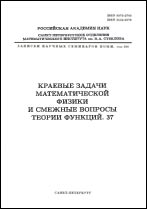|
|
Zapiski Nauchnykh Seminarov POMI, 2016, Volume 445, Pages 93–174
(Mi znsl6276)
|
 |
|
 |
This article is cited in 6 scientific papers (total in 6 papers)
Bounded remainder sets
V. G. Zhuravlev
Vladimir State University, Vladimir, Russia
Abstract:
We consider the category $(\mathcal{T,S,X})$ consisting of transformations $\mathcal{S\colon T\to T}$ of spaces $\mathcal T$ with distinguished subsets $\mathcal{X\subset T}$. Let $r_\mathcal X(i,x_0)$ be the distribution function of points from the $\mathcal S$-orbit $x_0,x_1=\mathcal S(x_0),\dots,x_{i-1}=\mathcal S^{i-1}(x_0)$ got in $\mathcal X$, and a deviation $\delta_\mathcal X(i,x_0)$ be defined by the equation
$$
r_\mathcal X(i,x_0)=a_\mathcal Xi+\delta_\mathcal X(i,x_0),
$$
where $a_\mathcal Xi$ is the average value. If $\delta_\mathcal X(i,x_0)=O(1)$ then such $\mathcal X$ are called bounded remainder sets. In this article the bounded remainder sets $\mathcal X$ are built in the following cases: 1) the space $\mathcal T$ is a circle, a torus or a Klein bottle; 2) the map $\mathcal S$ is a rotation of the circle, a shift or an exchange transformation of the torus; 3) the $\mathcal X$ is a fixed subset $\mathcal{X\subset T}$ or a sequence of subsets depending on the iteration step $i=0,1,2,\dots$
Key words and phrases:
toric exchange, induced decomposition, bounded remainder sets.
Received: 16.01.2016
Citation:
V. G. Zhuravlev, “Bounded remainder sets”, Analytical theory of numbers and theory of functions. Part 31, Zap. Nauchn. Sem. POMI, 445, POMI, St. Petersburg, 2016, 93–174; J. Math. Sci. (N. Y.), 222:5 (2017), 585–640
Linking options:
https://www.mathnet.ru/eng/znsl6276 https://www.mathnet.ru/eng/znsl/v445/p93
|

| Statistics & downloads: |
| Abstract page: | 285 | | Full-text PDF : | 47 | | References: | 35 |
|




 Contact us:
Contact us: Terms of Use
Terms of Use
 Registration to the website
Registration to the website Logotypes
Logotypes








 Citation in format
Citation in format 
